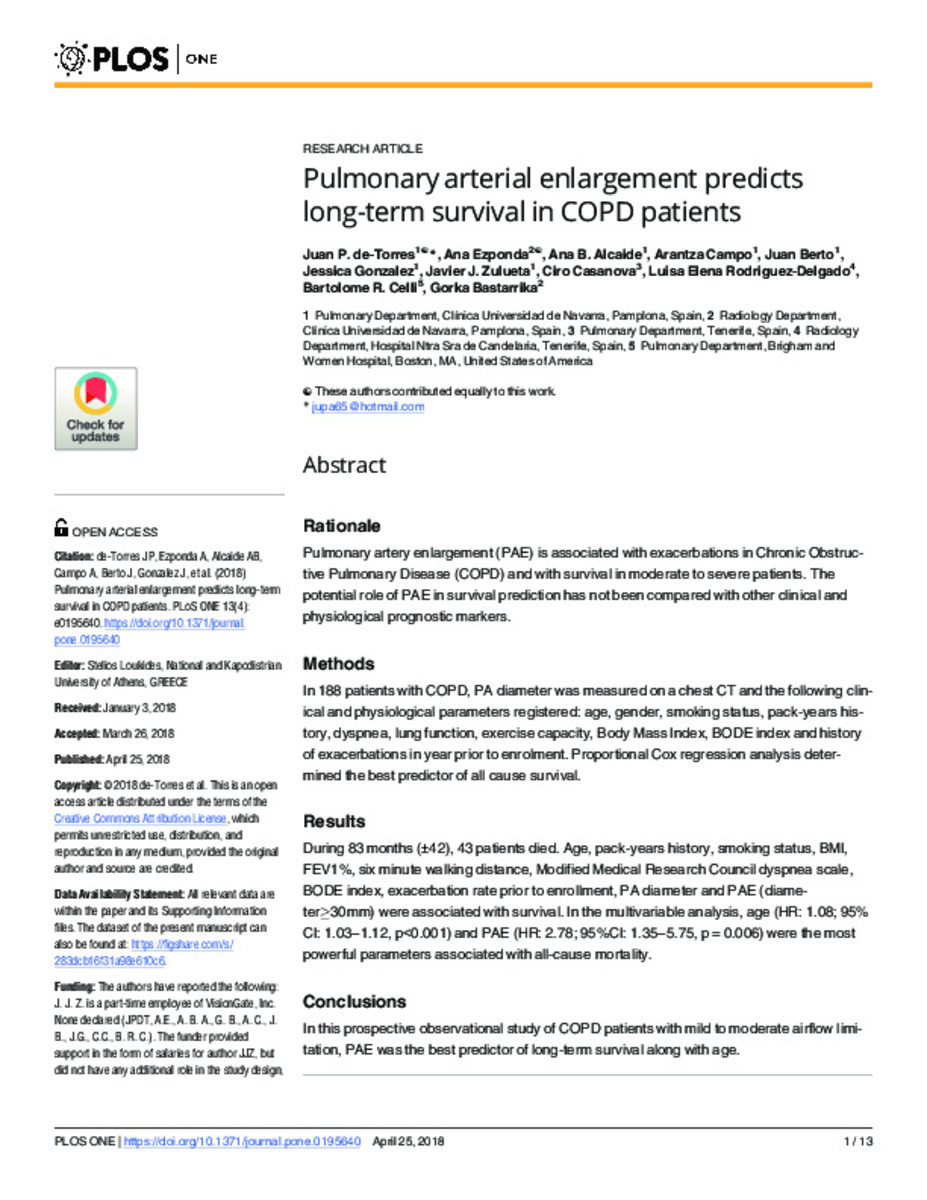Full metadata record
| DC Field | Value | Language |
|---|---|---|
| dc.creator | Torres, J.P. (Juan P.) de | - |
| dc.creator | Ezponda, A. (Ana) | - |
| dc.creator | Alcaide, A.B. (Ana Belén) | - |
| dc.creator | Campo, A. (Arantza) | - |
| dc.creator | Bertó, J. (Juan) | - |
| dc.creator | González, J. (Jessica) | - |
| dc.creator | Zulueta, J. (Javier) | - |
| dc.creator | Casanova, C. (Ciro) | - |
| dc.creator | Rodriguez-Delgado, L.E. (Luisa Elena) | - |
| dc.creator | Celli, B.R. (Bartolomé R.) | - |
| dc.creator | Bastarrika, G. (Gorka) | - |
| dc.date.accessioned | 2022-09-13T10:59:44Z | - |
| dc.date.available | 2022-09-13T10:59:44Z | - |
| dc.date.issued | 2018 | - |
| dc.identifier.citation | Torres, J.P. (Juan P.) de; Ezponda, A. (Ana); Alcaide, A.B. (Ana Belén); et al. "Pulmonary arterial enlargement predicts long-term survival in COPD patients". Plos One. 13 (4), 2018, e0195640 | es_ES |
| dc.identifier.issn | 1932-6203 | - |
| dc.identifier.uri | https://hdl.handle.net/10171/64325 | - |
| dc.description.abstract | Rationale Pulmonary artery enlargement (PAE) is associated with exacerbations in Chronic Obstructive Pulmonary Disease (COPD) and with survival in moderate to severe patients. The potential role of PAE in survival prediction has not been compared with other clinical and physiological prognostic markers. Methods In 188 patients with COPD, PA diameter was measured on a chest CT and the following clinical and physiological parameters registered: age, gender, smoking status, pack-years history, dyspnea, lung function, exercise capacity, Body Mass Index, BODE index and history of exacerbations in year prior to enrolment. Proportional Cox regression analysis determined the best predictor of all cause survival. Results During 83 months (±42), 43 patients died. Age, pack-years history, smoking status, BMI, FEV1%, six minute walking distance, Modified Medical Research Council dyspnea scale, BODE index, exacerbation rate prior to enrollment, PA diameter and PAE (diameter≥30mm) were associated with survival. In the multivariable analysis, age (HR: 1.08; 95%CI: 1.03–1.12, p<0.001) and PAE (HR: 2.78; 95%CI: 1.35–5.75, p = 0.006) were the most powerful parameters associated with all-cause mortality. Conclusions In this prospective observational study of COPD patients with mild to moderate airflow limitation, PAE was the best predictor of long-term survival along with age. | es_ES |
| dc.description.sponsorship | The authors have reported the following: J. J. Z. is a part-time employee of VisionGate, Inc. None declared (JPDT, A.E., A. B. A., G. B., A. C., J. B., J.G., C.C., B. R. C.). The funder provided support in the form of salaries for author JJZ, but did not have any additional role in the study design, data collection and analysis, decision to publish, or preparation of the manuscript. The specific roles of this author is articulated in the ’author contributions’ section. | es_ES |
| dc.language.iso | eng | es_ES |
| dc.publisher | Public Library of Science | es_ES |
| dc.rights | info:eu-repo/semantics/openAccess | es_ES |
| dc.subject | Chronic obstructive pulmonary disease | es_ES |
| dc.subject | Sports and excercise medicine | es_ES |
| dc.subject | Pulmonary arteries | es_ES |
| dc.subject | Ephysema | es_ES |
| dc.subject | Dyspnea | es_ES |
| dc.subject | Body mass index | es_ES |
| dc.subject | Medicine and health science | es_ES |
| dc.subject | Aorta | es_ES |
| dc.title | Pulmonary arterial enlargement predicts long-term survival in COPD patients | es_ES |
| dc.type | info:eu-repo/semantics/article | es_ES |
| dc.description.note | This is an open access article distributed under the terms of the Creative Commons Attribution License, which permits unrestricted use, distribution, and reproduction in any medium, provided the original author and source are credited. | es_ES |
| dc.identifier.doi | 10.1371/journal.pone.0195640 | - |
| dadun.citation.number | 4 | es_ES |
| dadun.citation.publicationName | Plos One | es_ES |
| dadun.citation.startingPage | e0195640 | es_ES |
| dadun.citation.volume | 13 | es_ES |
Files in This Item:
Statistics and impact
Items in Dadun are protected by copyright, with all rights reserved, unless otherwise indicated.






